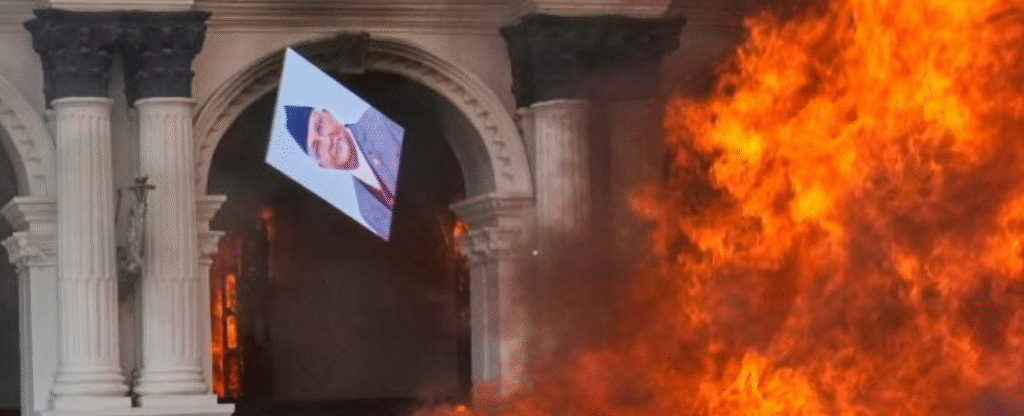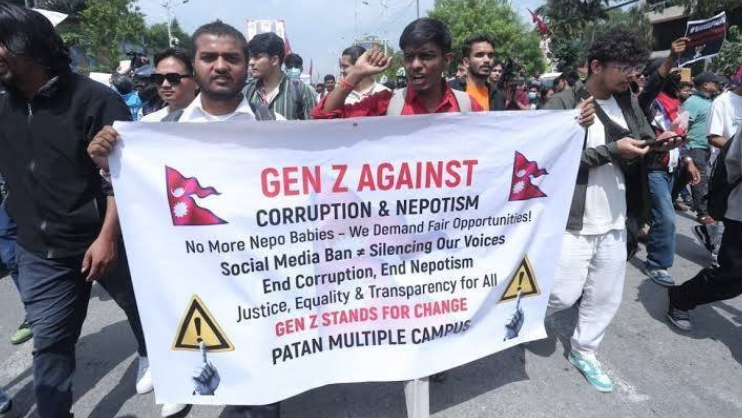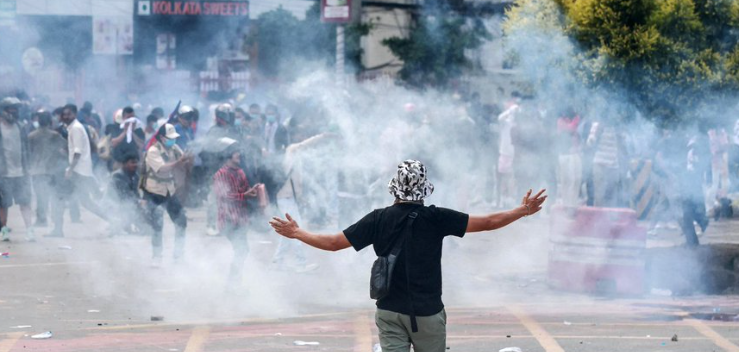Dateline: September 10, 2025 — A nationwide Nepal protest movement led by young people has plunged Nepal into political chaos. The protests began over a sudden ban on major social media platforms. They quickly widened into a mass outcry against corruption, nepotism, and poor job prospects. The unrest turned deadly. At least 19 people were killed and hundreds were injured in clashes with security forces. By Tuesday, Prime Minister K.P. Sharma Oli had resigned as anger and unrest spread.

What happened — the short version
The Nepal protest started as a digital backlash. The government ordered Facebook, X, YouTube, and other platforms to register under new rules. The move was seen as heavy-handed. Young users pushed back. Hashtags and viral posts on the platforms exposed alleged corruption and lavish lifestyles of elite families. That inflamed anger among students and young workers. The protests grew in cities across Nepal. Demonstrators marched toward Singha Durbar and the parliament. Police used tear gas, rubber bullets, and, in some cases, live rounds. At least 19 people were killed. Hundreds were injured. The unrest saw government buildings and politicians’ homes attacked and set on fire.
India’s statement on situation in Nepal: India on Tuesday advised its citizens in Nepal to “exercise caution” and follow instructions from Nepali authorities as Kathmandu imposed a curfew from 8:30 a.m. until further notice; New Delhi also put the 1,751-km India–Nepal border on heightened alert and stepped up patrols to prevent any spillover, while major carriers including IndiGo and Air India suspended flights to Kathmandu because the airport was disrupted—travelers should avoid protest areas, stay indoors, monitor airline and embassy updates, and use official helpline numbers if they need consular help.
Prime Minister Narendra Modi X handle Post:- On my return from Himachal Pradesh and Punjab today, a meeting of the Cabinet Committee on Security discussed the developments in Nepal. The violence in Nepal is heart-rending. I am anguished that many young people have lost their lives. The stability, peace and prosperity of Nepal are of utmost importance to us. I humbly appeal to all my brothers and sisters in Nepal to support peace.
Timeline and scale of the unrest
On September 8, 2025, mass demonstrations erupted in Kathmandu and dozens of other towns. Protesters, many from Gen Z, gathered near the federal parliament. They demanded the lifting of the social media restrictions and action against corruption. Police and security forces tried to repel the crowds. Clashes turned violent throughout the day and into the night. At least 19 people died in the police fire or in the chaos. More than 300 people were reported injured. Protests spread to cities including Pokhara, Biratnagar, Birgunj, and Janakpur. On September 9, following escalating violence, Prime Minister Oli resigned amid pressure. Protesters set fire to parts of the Singha Durbar complex and stormed the parliament building. The government then lifted the social media ban, but unrest continued.
Why the Nepal protest exploded so fast

The trigger was a social media crackdown. The government announced rules requiring platforms to register and comply with local directives. The move hit at the heart of how young Nepalis communicate. Many saw it as censorship. That anger mixed with long-standing grievances. Young people pointed to corruption. They pointed to joblessness. They pointed to perceived privilege among political families. A viral trend labelled “Nepo Kid” highlighted the contrast between public hardship and private wealth among elites. That mix turned an online protest into a street uprising. Observers say the youth-led Nepal protest was as much about dignity and opportunity as it was about digital rights.
The human cost and rights concerns
The death toll and injuries shocked the country. Early official counts put the dead at 19. Human Rights Watch and other groups said security forces used lethal force against largely peaceful protesters. Rights organisations demanded independent investigations into the killings. Domestic human rights bodies called for restraint and for immediate medical help for the wounded. International rights groups warned of potential abuses in the crackdown. The casualties deepened public fury and intensified the Nepal protest movement.
Political fallout — Oli quits, a caretaker government, and more uncertainty
Prime Minister K.P. Sharma Oli resigned on September 9, 2025, after mass demonstrations and mounting pressure. His departure came after weeks of rising discontent with his government’s handling of the economy and corruption allegations. President Ram Chandra Poudel accepted Oli’s resignation and, according to some reports, assigned him to lead a caretaker administration for a short period. The abrupt turn of events has left a power vacuum and legal questions about who will form the next government. Political parties are scrambling. Protest groups demand not just resignations but systemic reforms. The Nepal protest movement now seeks a long-term change in how the country is governed.
The symbolic role of youth and social media

The Nepal protest is notable for its youth leadership. Students, digital natives, and young professionals drove the movement. They used encrypted messages, memes, and in-person flash rallies. Symbols of global youth culture — popular manga icons and internet memes — appeared on the streets. These symbols gave the movement energy and allowed it to scale quickly. Observers draw parallels with other youth-led movements across the world. In Nepal’s case, the ban on social platforms sharpened focus and radicalised many who had previously been politically quiet.
Key events in different cities
The Nepal protest started in Kathmandu but spread to the Terai and the far west. In Biratnagar and Birgunj, large crowds also faced police lines. In some towns, protesters attacked the residences of political leaders. In Kathmandu, demonstrators attempted to enter the parliament complex and set fire to parts of Singha Durbar. The airport in Kathmandu temporarily shut down amid security concerns. The widespread nature of the unrest underlined deep nationwide frustration.
Government response and actions taken

The government initially imposed curfews and called in security forces to disperse crowds. It ordered the blocking of multiple platforms, citing concerns about misinformation and fraud. After the protests turned deadly and the nepal protest intensified, officials reversed course and lifted the social media restrictions within about a day. The rapid back-and-forth exposed the administration’s miscalculation and added to public distrust. Authorities have announced inquiries, but critics call them too slow and too tied to the police and political networks that are already under suspicion.
International reaction and regional concerns
Foreign governments followed events with alarm. India issued travel advisories and helped set up helplines for its citizens. Diplomatic missions urged calm and called for restraint. International organisations — including the UN human rights office — asked for investigations into the use of force. Regional analysts warned that turmoil in Nepal could have broader implications for South Asia. Nepal shares porous borders with India and China, and instability could affect cross-border trade and security. The Nepal protest has thus drawn attention from regional capitals and international rights groups.
Media coverage and misinformation risks
The Nepal protest was fuelled by online content. Viral videos, some verified and others not, circulated widely. That made it hard to separate fact from fiction during the first crucial hours. The government argued that tighter rules were needed to stop fraud and misinformation. Critics said the rules were a pretext for censorship. Independent fact-checkers and major news outlets scrambled to verify posts. The rapid spread of videos showing violence increased panic and pushed more people into the streets. That dynamic made the Nepal protest grow faster than past movements.
Economic and social consequences
The unrest hit business and daily life. Markets closed early. Offices shut. Airways and transport services were disrupted. The temporary shutdown of Kathmandu’s airport halted some flights and affected tourism. For many Nepalis, the immediate worries now include loss of income and how to access basic services amid curfews. Longer-term effects may include a hit to investor confidence. The Nepal protest has increased uncertainty about policy stability and the country’s economic direction. International aid and investment plans could be put on hold until the political picture clears.
A generator of anger and grief, the Nepal protest brought grieving families and enraged youth into the same space. Students chanted for accountability. Parents worried about their children being arrested or hurt during clashes. Middle-aged citizens demanded jobs and an end to patronage politics. Protesters described the moment as an opportunity to reset Nepali politics. Many said they wanted clean governance and more economic opportunity. They also said the social media ban had been the last straw. Journalists and medics described chaotic scenes in which both protesters and security forces suffered.
What analysts say — short and medium-term outlook
Analysts warn that the Nepal protest is unlikely to fade quickly. The youth movement is broad and has clear demands. Political parties are fractured, and some have lost legitimacy. The immediate test is who forms the next government and whether ministers implicated by the protesters face real legal scrutiny. If a credible, reform-minded administration does not emerge, the protests could return in waves. If the state responds with further repression, the unrest could worsen. Economists note that political instability could harm tourism and remittance flows, both vital to Nepal’s economy. Analysts emphasise the need for transparent investigations and meaningful reforms to calm the crisis.
Legal and constitutional questions
Oli’s resignation raises legal questions. Nepal’s constitution and parliamentary procedures will shape how a new leader is selected. Some observers worry about a power grab by old elites. Others hope for a broad coalition that includes younger voices. The Nepal protest movement has called for structural change, including tougher anti-corruption measures and more open governance. How these demands are translated into policy will determine the movement’s long-term impact.
Humanitarian needs and medical response
Hospitals in Kathmandu reported an influx of wounded. Medical teams and volunteers rushed to help. Rights groups asked for safe passage for the injured and for independent monitors to document abuses. The Nepal protest has highlighted gaps in emergency response in some districts. Humanitarian agencies are monitoring the situation for possible needs, especially if curfews and violence continue. The health system’s ability to care for hundreds of injured people is a pressing practical concern in the days after the clashes.
Also visit:- mineverse360
What protesters want now
Protest leaders list clear demands. These include:
- Accountability for those responsible for the killings during the protests.
- Independent investigations into police conduct.
- End to political nepotism and corrupt patronage.
- Job programs and better economic opportunities for youth.
- Legal protections for online freedom and rollback of repressive internet rules.
The Nepal protest movement seeks both immediate accountability and long-term political reform. How political leaders respond will shape whether the protests become a turning point or a temporary uprising.
What to watch in the next 72 hours
Observers say the next three days are critical. Key signals to watch:
- Who will lead the interim government, and will it include reform-minded figures?
- Whether an independent, credible probe into the deaths is launched.
- If security forces remain on high alert or step back to allow peaceful demos.
- Whether protests spread to more districts or settle down.
- How international actors respond in terms of aid, travel advisories, or political pressure.
X users post
User:- Nepal's ex-prime minister's wife was brunt alive during protest today which led to her death.
User:- Nepal main Sadan gurung ki ek post pe hua revolution. Gurung ne likha tha 'Nepo Kids' .. Bas iske baad hamle shuru hue. Iska Matlab ki poori duniya nepotism ke khilaf protest karne lagi hai. Nepali CONGRESS aur Communist jalaye aur maare ja rahe hain wahan.
User:- The protest in Nepal,has claimed the lives of 19 people, resignation of the prime minister, K.P Sherma Oli,a destruction of his residence in Baluwatar and other government buildings. The protest wasn’t just over the social media ban but also a request for a young leader.
User:- All i know is this gen-z protest against the corrupt govt will be used smartly to employ Pro-USA leader in Nepal. Nepal should remain a sovereign & independent state. Choose your leader wisely, & kick anyone having links with China or USA.
A fragile moment for Nepal
The Nepal protest of September 2025 is a defining moment. It is young, fast-moving, and rooted in both digital culture and old grievances. The deaths and the attack on key state institutions mark a sharp rupture. Yet the movement also shows the capacity of youth to organise and demand change. Nepal now faces a choice. It can respond with transparent justice and reforms. Or it can return to the old cycle of weak accountability and political brinkmanship. The coming days will reveal which path Nepal takes. The world is watching Nepal Protest.
